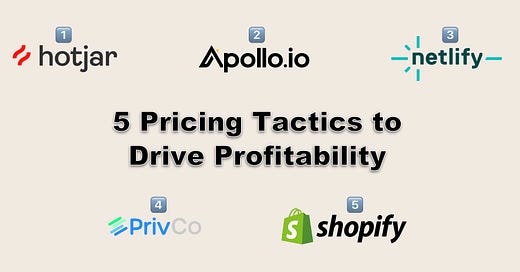Profitability is the name of the game right now.
After watching the key players in SaaS for the last year, I’ve compiled some of the tactics I’ve seen in the push towards profitability — the good, the bad, and the ugly.
But first — a quick round-up of SaaS pricing moves over the last couple weeks.
🛠️ SaaS Moves
ActiveCampaign introduced a new Lite plan for $29 per month, targeting individuals and small teams.
Zoom added a new Notes feature to all pricing plans.
Autodesk raised prices for 3-year and annual subscriptions.
Apollo dropped the price of its Basic plan and lowered the usage limits.
DocuSign added a limited-time 20% promotion for Annual plans.
PS. I spotted these updates using PricingSaaS. Sign up for free to take your pricing SaaS pricing strategy to the next level.
In the push towards profitability, SaaS companies are generally looking for ways to reduce the ratio between value and price.
In the best of times, it seemed many SaaS players, especially those with a heavy focus on PLG, were excessively generous with value — looking to be the solution that gives the customer the most bang for their buck.
Now that equation has been reversed — SaaS companies want more buck for the bang they are delivering (that sounds bad — but you know what I mean!).
Some of the strategies below are obvious; others are more creative, all of them seem geared towards reversing that value equation. If you can think of others, I’d love to hear them in the comments!
1️⃣ Lower Usage Limits (AKA Shrinkflation)
This is when companies keep the price of a plan the same, but lower the usage allowance. It's become increasingly popular on free and low-end tiers.
Example: ConvertKit ran a test where it lowered the number of subscribers allowed on its free plan from 1,000 to 300. More recently, Hotjar has been running a test where its lowering the daily session limits across its plans.
2️⃣ Price Change with Lower Usage Limits
This is when a company lowers usage limits, but lowers the price of the plan at the same time. The key here is that the unit economics fall in the company’s favor. There’s also an optics benefit — even if customers are getting less for their dollar, reducing the cost can soften the blow of lowering the usage limit alone.
Example: Apollo just did this. Previously, the Basic plan was $49 per month, and offered customers 12,000 export credits per year. This came out to a ratio of ~20 export credits per dollar. They recently lowered the price to $39 per month, and lowered the export limit to 3,000 credits per year — bringing the ratio to 6 export credits per dollar.
3️⃣ Plan Consolidation
Specifically, I’m seeing more companies get rid of middle tiers that don’t seem to have a clearly defined persona. This allows companies to more clearly position each tier, and can force them into a higher tier given their usage level.
Example: Netlify had a Business plan for $99 per month, and removed it earlier this year. In the new assortment, the usage limits on the Enterprise plan mirror what used to be available on Business. Enterprise pricing is custom, allowing Netlify to have more 1:1 conversations with high-usage customers. Another example of this is Prosumer plans — which seem to be disappearing.
4️⃣ Fake Discounts
This is when a company keeps the price of a plan the same, but retroactively adds a list price to reposition the existing price as a bargain.
Example: PrivCo did this earlier in the year and its still live on their website. Is this strategy silly? Yes. Does it work? I’m sure it can. Human psychology is a funny thing.
5️⃣ Raise Prices
The simplest of these strategies is just to raise prices — something most SaaS companies should probably do more frequently.
Example: Earlier this year, Shopify raised prices for the first time in 12 years. What’s interesting about that is subscription revenue has made up less and less of their revenue picture over the years. Shopify makes most of its money from “Merchant Solutions” revenue (the cut they take from transactions on the platform). Even so, at Shopify’s scale, raising prices just a little bit can have a material impact.
🔓 Unlock SaaS pricing cheat codes by referring friends to Good Better Best 🔓
1️⃣ The GBB Link Library: A growing list of my go-to SaaS pricing posts and podcasts, organized by topic and format.
3️⃣ PricingSaaS Slack Access: Track pricing changes from the biggest players in SaaS, follow PLG experiments, and more.
5️⃣ Free Pricing Assessment: A 30-minute call with me, where I’ll review your pricing questions and offer feedback and recommendations.




